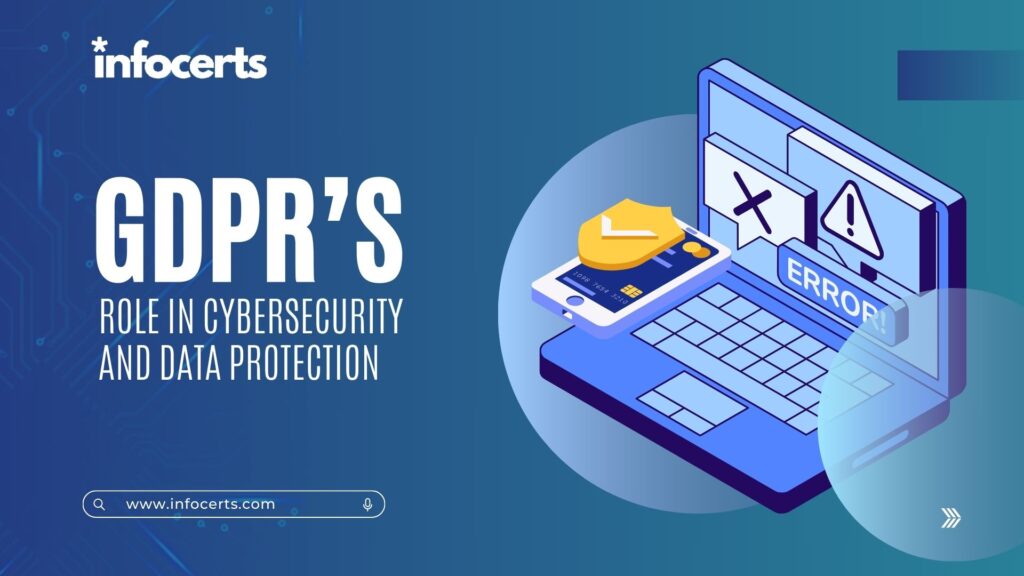The General Data Protection Regulation (GDPR) plays a crucial role in ensuring cybersecurity and data protection for organizations across the European Union (EU). With the increase in cyber threats and data breaches, GDPR is designed to enhance how organizations manage, store, and protect personal data. Let’s dive into how GDPR influences cybersecurity, focusing on key aspects such as data breach notifications, the role of Data Protection Officers (DPOs), best practices, risk management, and handling breaches.
1. Data Breach Notification Under GDPR
One of the critical aspects of GDPR is the requirement for timely breach notifications. Under GDPR, organizations must notify supervisory authorities within 72 hours of becoming aware of a breach that risks the rights and freedoms of individuals. Failure to comply with this could result in hefty fines.
Table: Steps for Data Breach Notification
| Step | Action Required |
|---|---|
| Identify the breach | Assess the breach’s nature and scope. |
| Notify authorities | Inform authorities within 72 hours of awareness. |
| Notify individuals (if needed) | If the breach impacts personal data, notify affected individuals. |
| Mitigation | Implement corrective measures to prevent future breaches. |
Important Note: When notifying authorities, ensure the report includes details of the breach, its impact, and the actions taken to mitigate risks.
2. Role of Data Protection Officers (DPO)
GDPR mandates that organizations appoint a Data Protection Officer (DPO) if they process large amounts of personal data. The DPO is responsible for overseeing the organization’s data protection strategy and ensuring compliance with GDPR regulations. They also act as the point of contact between the organization and regulatory authorities.
Key responsibilities of a DPO:
- Monitoring GDPR compliance
- Conducting data protection impact assessments
- Advising on data security practices
- Liaising with data subjects and authorities
Having a DPO is essential in aligning your cybersecurity framework with GDPR regulations.
Interested in becoming a GDPR expert? IT professionals can enroll in our comprehensive GDPR course. Contact us at infocerts at +91 70455 40400 for more details.
3. GDPR and Cybersecurity Best Practices
GDPR encourages the implementation of strong cybersecurity measures to protect personal data from unauthorized access and breaches. Below are some best practices to follow:
- Data encryption: Encrypt sensitive personal data to prevent unauthorized access.
- Access control: Limit access to personal data based on roles and responsibilities.
- Regular updates and patches: Ensure systems and software are up to date to prevent vulnerabilities.
- Incident response plan: Have a robust incident response plan in place to quickly address potential breaches.
Bold GDPR Course Details: Learn more about these best practices and how to incorporate them into your cybersecurity framework with our detailed [GDPR course].
4. Risk Management and Data Security
Risk management plays a pivotal role in aligning GDPR with cybersecurity. Organizations must conduct regular risk assessments to identify vulnerabilities in their data security infrastructure. This includes evaluating:
- Potential threats to personal data (e.g., hackers, phishing).
- Impact of a breach on individuals and the organization.
- Preventive measures such as encryption, data anonymization, and secure data disposal.
Risk Mitigation Strategies:
- Data minimization: Only collect the necessary data.
- Automated tools: Use tools to monitor suspicious activity.
- Employee training: Educate employees about security threats and GDPR compliance.
5. How to Handle a GDPR Data Breach
In the event of a GDPR data breach, swift action is crucial. Here’s a step-by-step guide:
- Contain the breach: Immediately isolate the affected systems and stop further access.
- Assess the damage: Determine the scope of the breach, what data was compromised, and its impact.
- Notify authorities: As per GDPR, inform authorities within 72 hours of discovery.
- Communicate with affected individuals: If the breach is severe, notify individuals whose data has been compromised.
- Document the breach: Maintain records of the breach, the response, and preventive actions.
To learn more about handling GDPR data breaches, check out our [GDPR course] designed for IT professionals.
Conclusion
GDPR is a comprehensive regulation that not only focuses on data protection but also strengthens an organization’s overall cybersecurity practices. By implementing robust breach notification processes, appointing a skilled DPO, following cybersecurity best practices, and actively managing risks, businesses can ensure compliance while protecting sensitive data from threats.
For more detailed insights on GDPR and its role in cybersecurity, consider enrolling in our specialized [GDPR course]. IT professionals can contact INFOCERTS at +91 70455 40400 to sign up today.

